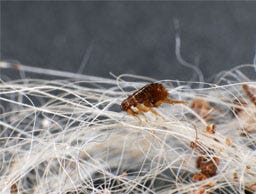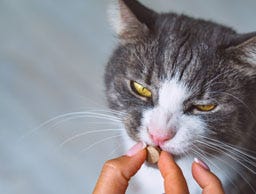How Do Flea Treatments Work?
Treating your pet for fleas is one of the crucial aspects of any pet's at-home healthcare routine. But how do you know if you're choosing the right one? With so many different formulas and brands available, it's easy to get mixed up trying to find a treatment that suits both yours and your pet's needs. That's wy we've put together this guide to how flea treatments work, including which active ingredients to look out for in popular over-the-counter flea treatments, so you know you pet is getting the very best.
Active Ingredients in Flea Treatments
Flea treatments have multiple components, but the key thing to look out for when picking a flea treatment is the active ingredients. These ingredients make the treatment do what it’s supposed to, and many flea treatments use the same ones, just sold under a different name.
For example, Advantage flea treatments and Imidaflea spot-ons use the active ingredient Imidacloprid to kill adult fleas living on your pet. Other common active ingredients include, but are not limited to:
- Fipronil
- Flumethrin
- S-Methoprene
- Pyriproxyfen
Some of these ingredients are chemical pesticides the kill the adult fleas on your pet and in their environment, while others are insect growth regulators which target the flea's eggs and larvae, preventing them from hatching or maturing into adult fleas. Some flea treatments, such as the Beaphar FIPROtec® COMBO flea treatments, will use a combination of an insecticide and an insect growth regulator (in this case, Fipronil and (S)-methoprene) as active ingredients to provide an efficient means of breaking the flea life cycle to treat infestations on your pet.
When looking at flea treatments for your pet, take into account what your pet needs from their parasite control. If you're treating them preventatively each month, then a flea treatment targeting and repelling adult fleas on your pet may be enough. If you’re trying to treat an infestation, you should aim for a treatment that targets every stage of the flea lifecycle.
If you’re unsure about what treatment would be best for your pet, speak with your veterinarian for recommendations.
How Do Spot-On Flea Treatments Work?
Spot-on flea treatments are perhaps the most popular form of flea treatments thanks to their ease of application and the fact that they come pre-dosed depending on your pet’s weight. Each pre-dosed pipette is filled with a flea-killing liquid that, once applied to your pet’s skin, kills any fleas on your pet and continues to do so for a stretch of time. This is typically up to 4 weeks for over-the-counter flea treatments, but for prescription treatments, it could be up to 3 months, depending on the manufacturer.
There are two key types of flea spot-on treatments: those that kill fleas after they bite your pet and those that kill fleas who come into contact with your pet. Both of these methods are effective ways of treating your pet, but they work in slightly different ways, and which is more suitable for your pet will depend on your pet. For example, those with flea bite allergies are best treated with a kill-on-contact flea treatment to prevent further irritation or allergic reactions to the flea's saliva.
Once applied to your pet’s skin (find out how to apply a flea spot-on here), the flea-killing solution is absorbed into the skin and travels to one of two places:
- The fat beneath your pet’s skin where it can enter the bloodstream.
- Your pet’s sebaceous glands (microscopic organs in each of your pet’s hair follicles that release natural oils to prevent their skin from drying out)


Flea treatments that enter the bloodstream will require fleas to bite your pet, and once the active ingredients are ingested by the flea, they die. In kill-on-contact treatments, the ingredients are secreted through the sebaceous glands along with those natural oils, offering full body protection against fleas on your pet.
In some instances, these kill-on-contact treatments also spread to your pet's fur, meaning when they shed, the treatments will work to kill fleas that live in your home environment as well, preventing reinfestations. You can find our full range of spot-on flea treatments here.
How Do Flea Collars Work?
Flea collars are another popular choice for pet parasite control due to their long-lasting nature. Once on your pet, Seresto flea collars, for example, will keep your pet protected from fleas and ticks for 8 months before a new one is needed. This makes them popular choices for owners who struggle to keep track of when they last treated their pet for fleas or for animals with more free-roaming, like barn cats.
The way these collars work is not dissimilar to flea spot-ons as the active ingredients in flea collars are absorbed into your pet’s skin and coat
The active ingredients are typically contained within a polymer matrix within the collar. Once applied to your pet, the collar releases the active ingredient matrix into the lipid layer of your pet’s skin. This layer is like a barrier that keeps moisture in your pet’s skin but also keeps microbes out. Once in the lipid layer, the ingredients travel fast to cover the surface of your pet’s body, killing fleas living on your pet within 24 hours and repelling fleas and ticks for up to 8 months.
Since the ingredients work within the lipid layer of your pet’s skin, they can’t be washed off your pet, so bathing won’t hinder the treatment. These collars are suitable for use in both cats and dogs of varying sizes, although they should not be used on puppies under 8 weeks old, or kittens under 10 weeks.
Always read the datasheet provided when using flea collars to ensure they’re suitable for your pet, or speak with your vet for advice. You can browse our full range of flea collars for dogs and cats here.


How Do Flea Tablets Work?
Flea tablets are another option for flea treatments as they can be slipped into your pet’s food or even given as a treat if they’re of the flavoured, chewable variety. The active ingredients in over-the-counter flea tablets tend to be one of the following:
- Nitenpyram (effective against adult fleas)
- Lufenuron (effective against flea larvae)
- Spinosad (effective against adult fleas)
Once ingested, flea tablets work fast (some in as little as 30 minutes) as the active ingredient enters your pet’s fat, where it’s stored and transferred to fleas that bite your pet. The chemical kills these fleas by either blocking their nerve signals to cause paralysis and then death or by preventing the production of an exoskeleton in future larvae.
Many flea tablets that are available without a prescription have their drawbacks. For example, tablets that only contain lufenuron won't kill the adult fleas on your pet but will prevent their larvae from continuing on the cycle. Those containing Nitenpyram will kill adult fleas fast, but these effects don’t last very long, so they are better used as a short-term solution.
If you want flea tablets for dogs or cats offering more complete or longer-lasting protection, you’ll need to speak with your vet about a prescription flea treatment.
All flea treatments work in different ways, and not all of them will be suitable for your pet. Think about what it is you’re looking for from a flea treatment – are you treating an infestation, do you want long-lasting results, or are you just looking for simple preventative care. Remember, you can always speak to your vet for recommendations if you’re unsure or you’ve found over the counter treatments aren’t working for your pet.
If you know already know what you’re looking for, then head to the link below to browse our vast range of flea and tick treatments available in various formulas and from top-industry brands.
This post is an opinion and should only be used as a guide. You should thoroughly discuss any change to your pet’s care or lifestyle with your vet before starting any program or treatment.






























